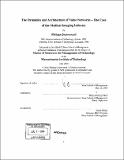| dc.contributor.advisor | Henry Birdseye Weil. | en_US |
| dc.contributor.author | Jeanrenaud, Philippe, 1962- | en_US |
| dc.contributor.other | Massachusetts Institute of Technology. Management of Technology Program. | en_US |
| dc.date.accessioned | 2005-06-02T18:59:24Z | |
| dc.date.available | 2005-06-02T18:59:24Z | |
| dc.date.copyright | 2004 | en_US |
| dc.date.issued | 2004 | en_US |
| dc.identifier.uri | http://hdl.handle.net/1721.1/17868 | |
| dc.description | Thesis (S.M.M.O.T.)--Massachusetts Institute of Technology, Sloan School of Management, Management of Technology Program, 2004. | en_US |
| dc.description | Leaf 105 blank. | en_US |
| dc.description | Includes bibliographical references (leaves 100-104). | en_US |
| dc.description.abstract | With the increase in strategic alliances and acquisitions, the firm needs to be studied in the context of the network of relationships in which it is embedded. This network not only extends the capabilities of the firm by establishing channels to access additional resources but it also creates additional constraints that have to be accounted for. This fundamental view is the backdrop of this research on the dynamics of the diagnostic medical imaging industry. This thesis explores a variety of network-based approaches to characterize the dynamics of the medical imaging industry. After reviewing the literature on the subject of alliances and inter-organizational networks, we describe the medical imaging industry in the United States. For our analysis, we have compiled a list of alliances and acquisitions launched in the last 15 years and used that list to create an overall network for the industry where each node is an industry subgroup. Along with the visual representation, we have compiled a number of network-based statistics such as distribution of sub-industry membership and centrality. We have examined the trends of those metrics in three time periods, 1980-1989, 1990-1999, and 2000-2003 and related those trends to the information gathered through several interviews with industry experts. Those trends are consistent with the consolidation that has taken place in the industry in the last 10 years. However they also show the emergence of new centers of activity such as the medical services industry segment. Overall, this network model provides a powerful framework to "visualize" the internal structure of the industry. Leveraging on the main findings revealed by the network-based analysis, we put forward a system dynamics model that combines the main trends | en_US |
| dc.description.abstract | (cont.) highlighted by our research. The model is the basis for a discussion on the potential evolution of the medical imaging ecosystem. While further centralization is expected, we anticipate that the role of the medical service industry segment and the contrast agent manufacturers may significantly weaken this centralization. | en_US |
| dc.description.statementofresponsibility | by Philippe Jeanrenaud. | en_US |
| dc.format.extent | 105 leaves | en_US |
| dc.format.extent | 5434311 bytes | |
| dc.format.extent | 5444793 bytes | |
| dc.format.mimetype | application/pdf | |
| dc.format.mimetype | application/pdf | |
| dc.language.iso | eng | en_US |
| dc.publisher | Massachusetts Institute of Technology | en_US |
| dc.rights | M.I.T. theses are protected by copyright. They may be viewed from this source for any purpose, but reproduction or distribution in any format is prohibited without written permission. See provided URL for inquiries about permission. | en_US |
| dc.rights.uri | http://dspace.mit.edu/handle/1721.1/7582 | |
| dc.subject | Management of Technology Program. | en_US |
| dc.title | The dynamics and architecture of value networks : the case of the medical imaging industry | en_US |
| dc.type | Thesis | en_US |
| dc.description.degree | S.M.M.O.T. | en_US |
| dc.contributor.department | Management of Technology Program. | en_US |
| dc.contributor.department | Sloan School of Management | |
| dc.identifier.oclc | 56611829 | en_US |
